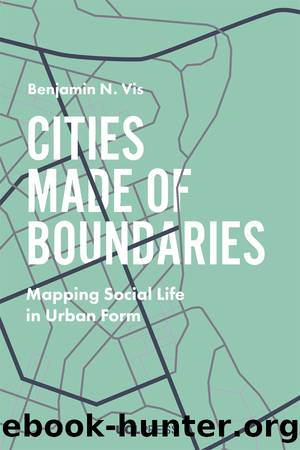Cities Made of Boundaries by Benjamin N. Vis

Author:Benjamin N. Vis
Language: eng
Format: epub
Publisher: UCL Press
Published: 2018-06-15T00:00:00+00:00
Comparative applicability of space syntax
How does space syntaxâs applicability fare in pursuit of radical cross-cultural and diachronic comparisons? As Steadman (2004: 484) puts it, one of its most significant findings is âthat the pattern of movement in a city or urban area is likely to be shaped to an extent by the topology of its route network alone, irrespective of all other factorsâ. The focus on the connectivity of continuous space in association with lines of sight implies an emphasis on movement and accessibility along streets and grids (e.g. Hillier 2007; Omer & Zafrir-Reuven 2010).
While seemingly pervasive, requiring the presence of formal streets or grids actually limits space syntaxâs immediate application to âstrange townsâ (Hillier 2007: 171ff.). This includes the irregular and dispersed geometry of Maya low-density patterns. Hillier (2007) explains his symbolic characterisation of Maya built form in opposition to the instrumentality of ânormal townâ. Such opposition flagrantly brushes over the fact that these cities must be functional everyday living spaces just the same (also Hohman-Vogrin 2005, 2006).29 Maya cities are known to have few formal streets (Magnoni et al. 2012), while they do contain much differently organised open space (Chapter 7 demonstrates these can be designated with BLTs). Griffiths (2011; Griffiths & Quick 2005) suggests better suited social and historical analyses might become possible through critical reconsideration of space syntaxâs foundation, and progressive adaptations of its spatial concepts and analytical measures. Indeed, explorative urban space syntax applications are carefully being attempted by Mesoamerican archaeologists (Morton et al. 2012a, 2012b; Parmington 2011 for an elaborate Maya example of architectural access analysis).
In radical comparisons the appropriateness of formal functional space categories such as streets and grids becomes dubious. For such purpose predictive and probabilistic claims seem misplaced, and are therefore best replaced by a more explorative mode of research. For that reason the theoretical framework of BLT Mapping will not contend probability. In other words, spatial dependence does not elicit a direct causal relation between built space and what will actually occur in space, including movement. Yet, social theory would not deny that spatial configuration affords the interconnectivity and permeability which promotes movement and land-use. Instead, movement is present as a presupposition; part of âacting manâ. By mapping BLTs, the socio-spatial conditions in which movement or any other use takes place becomes qualitatively characterised with formal descriptions of each space and positioned within the configuration. Doing so may narrow down likely functions within materialised spatial settings (cf. Sayerâs (2000) spatial independence), but does not express the probability of something occurring within a specific space.
When granting time a substantive role (see Griffiths 2011), the relationship between human action and layout is recursively constitutive (or continuously dialectical). Therefore preferential causal weight can neither be allocated to the configuration nor to land-use locations as fixed attractors in which specific actions dominate (cf. Hillier et al. 1993). Historically speaking, predicting what will occur is particular to present socio-cultural values and processes. It can be agreed that through its common application to road networks and
Download
This site does not store any files on its server. We only index and link to content provided by other sites. Please contact the content providers to delete copyright contents if any and email us, we'll remove relevant links or contents immediately.
Kathy Andrews Collection by Kathy Andrews(10554)
The remains of the day by Kazuo Ishiguro(7577)
Spare by Prince Harry The Duke of Sussex(4222)
Paper Towns by Green John(4178)
The Body: A Guide for Occupants by Bill Bryson(3816)
Be in a Treehouse by Pete Nelson(3234)
Harry Potter and the Goblet Of Fire by J.K. Rowling(3078)
Goodbye Paradise(2977)
Never by Ken Follett(2910)
Into Thin Air by Jon Krakauer(2711)
The Remains of the Day by Kazuo Ishiguro(2627)
The Genius of Japanese Carpentry by Azby Brown(2616)
The Cellar by Natasha Preston(2605)
Drawing Shortcuts: Developing Quick Drawing Skills Using Today's Technology by Leggitt Jim(2537)
120 Days of Sodom by Marquis de Sade(2446)
Architecture 101 by Nicole Bridge(2356)
Machine Learning at Scale with H2O by Gregory Keys | David Whiting(2317)
The Man Who Died Twice by Richard Osman(2309)
Industrial Automation from Scratch: A hands-on guide to using sensors, actuators, PLCs, HMIs, and SCADA to automate industrial processes by Olushola Akande(2127)
